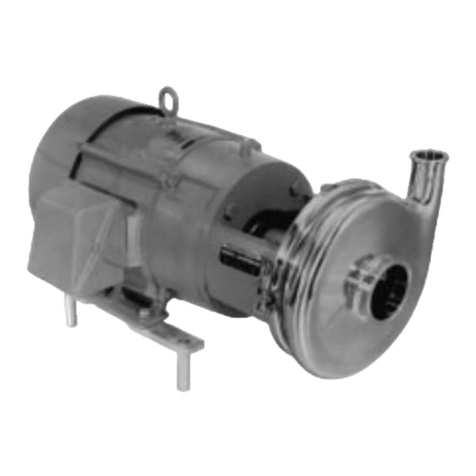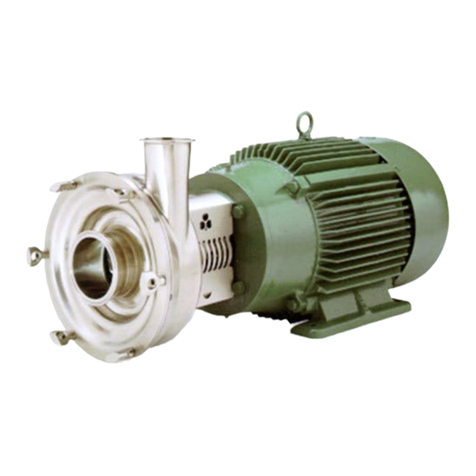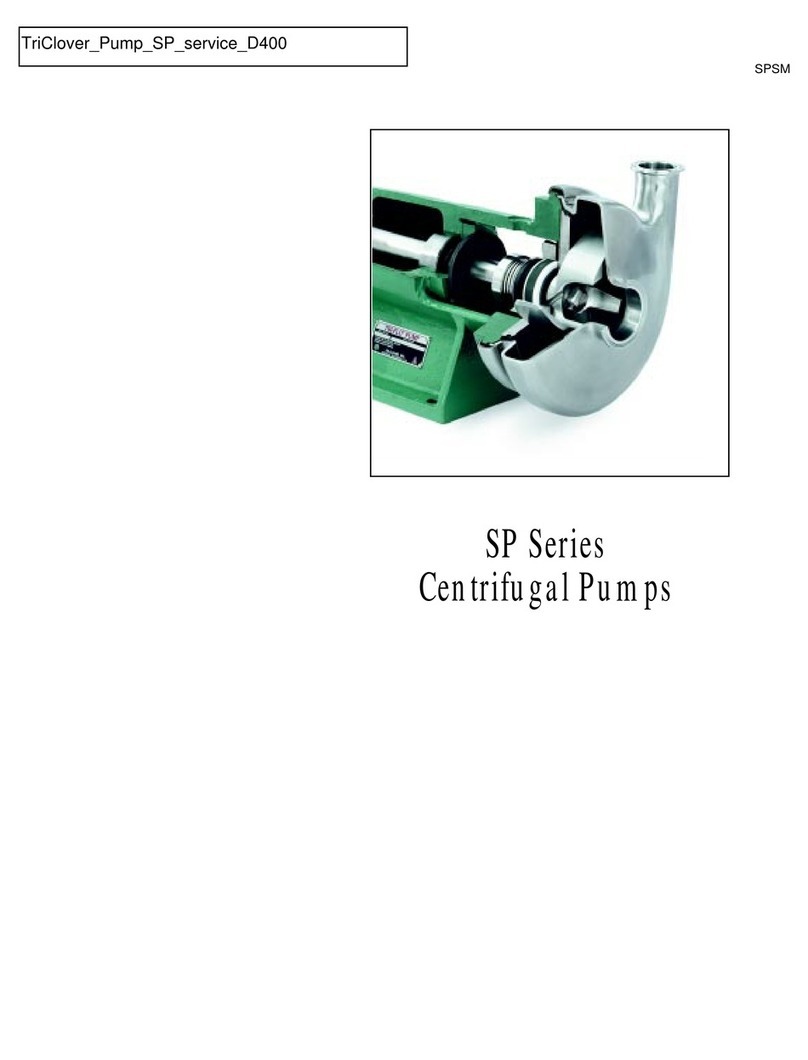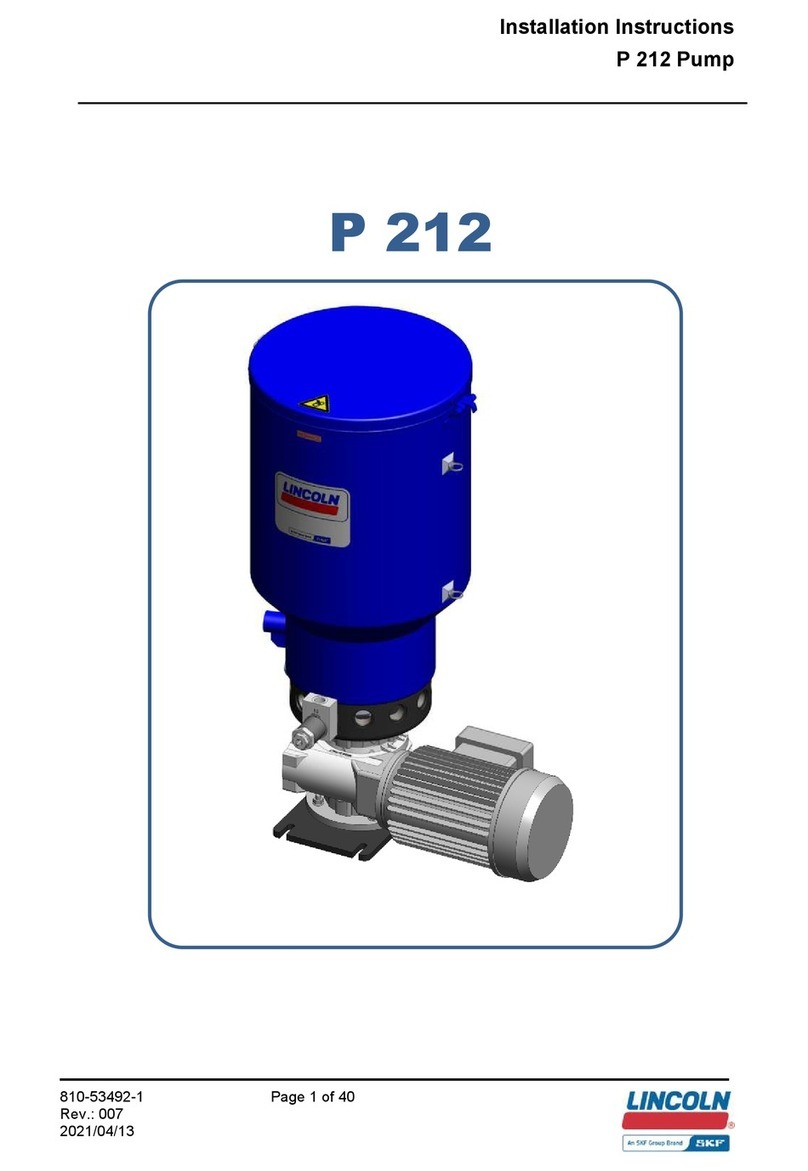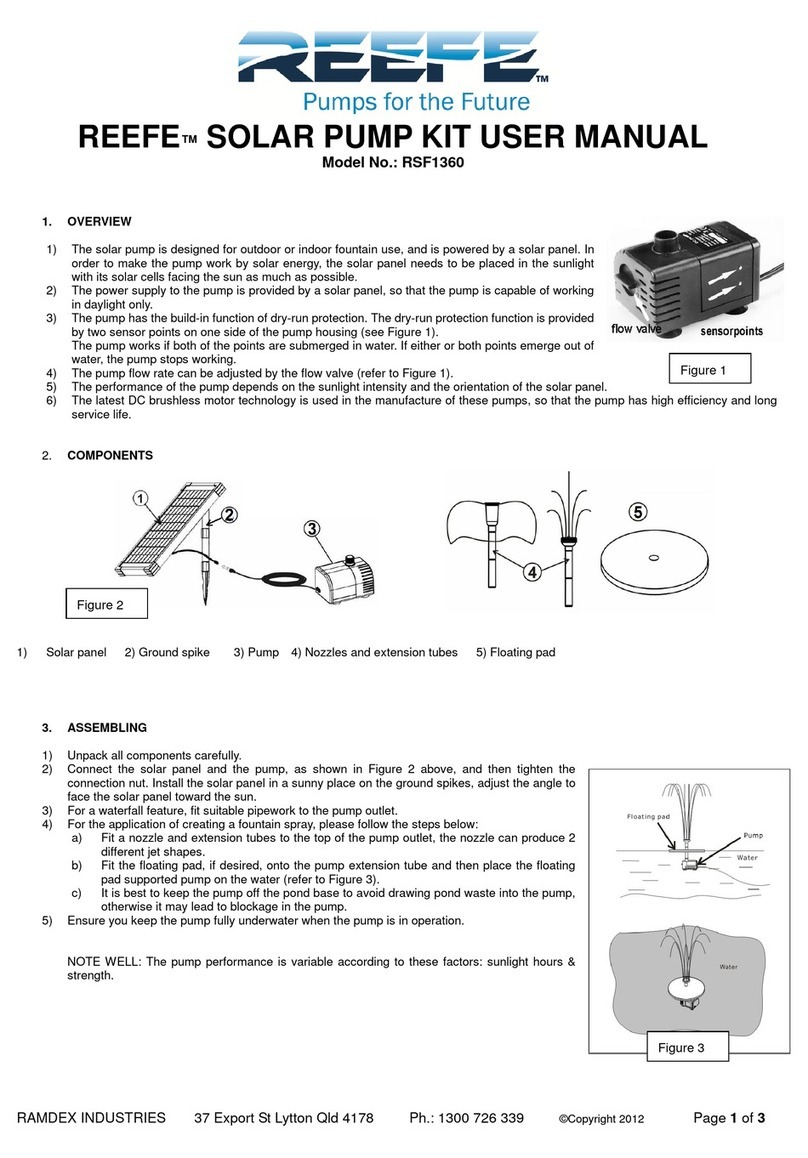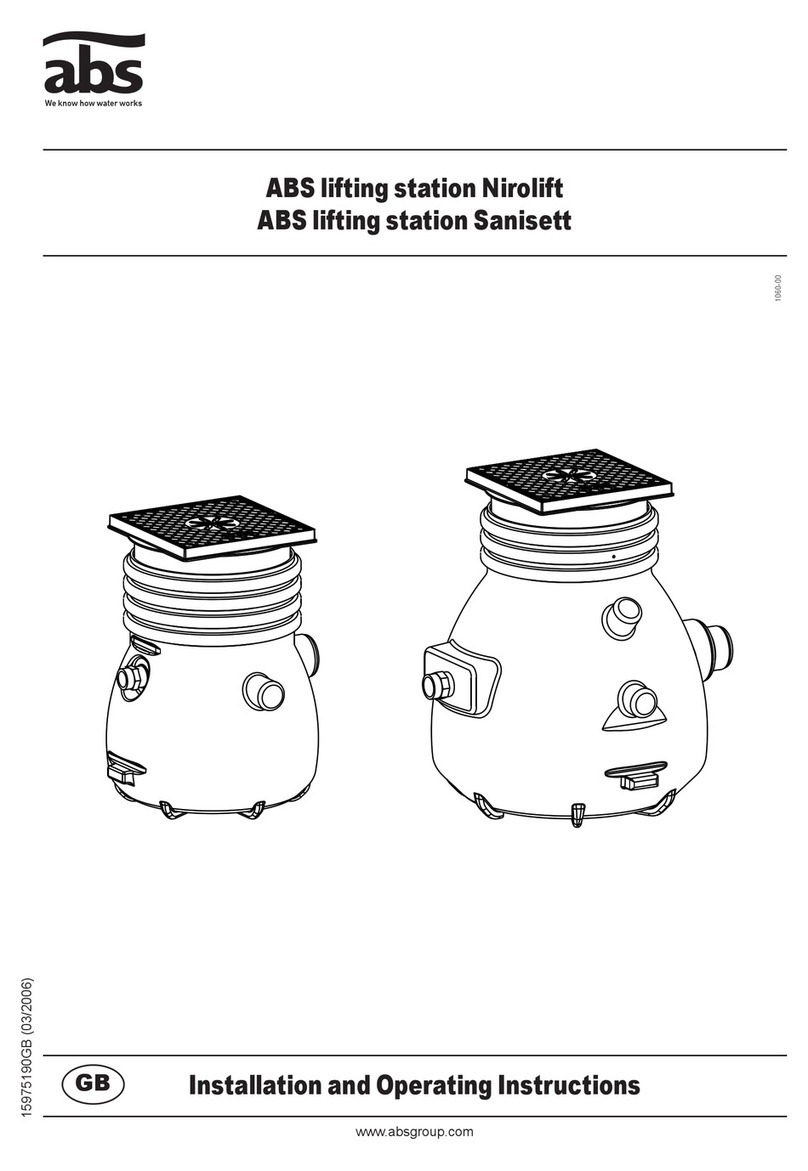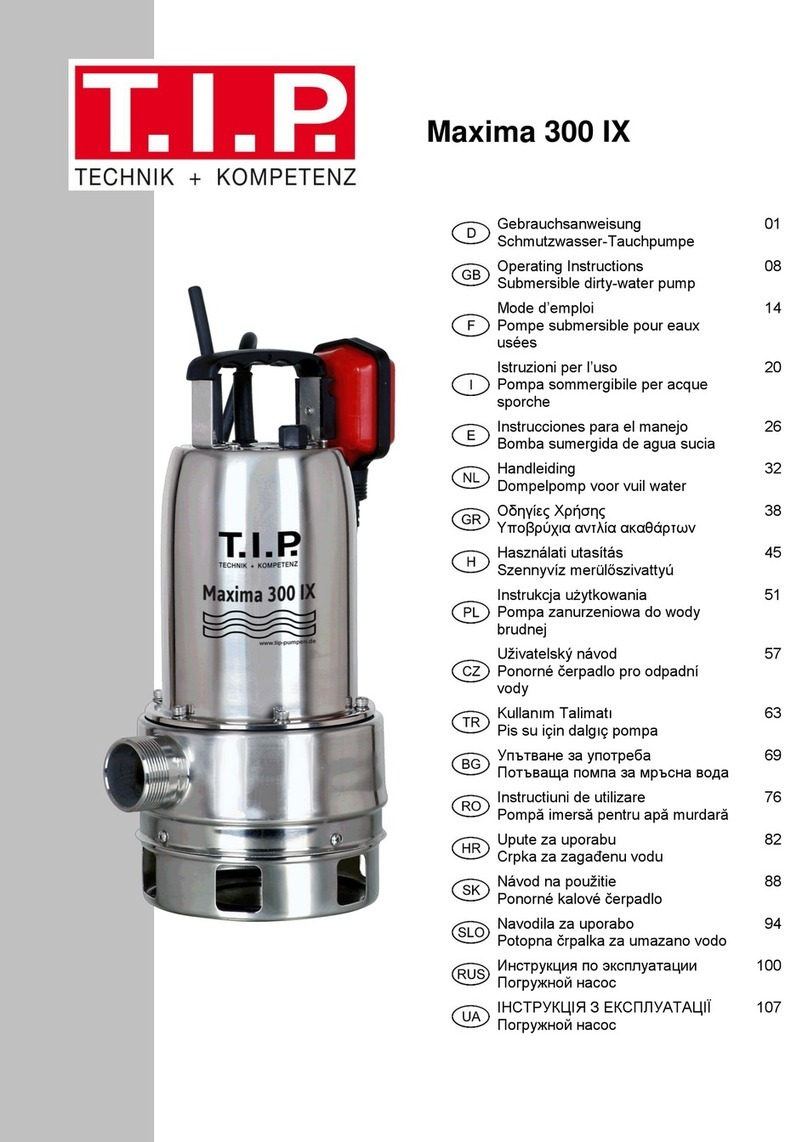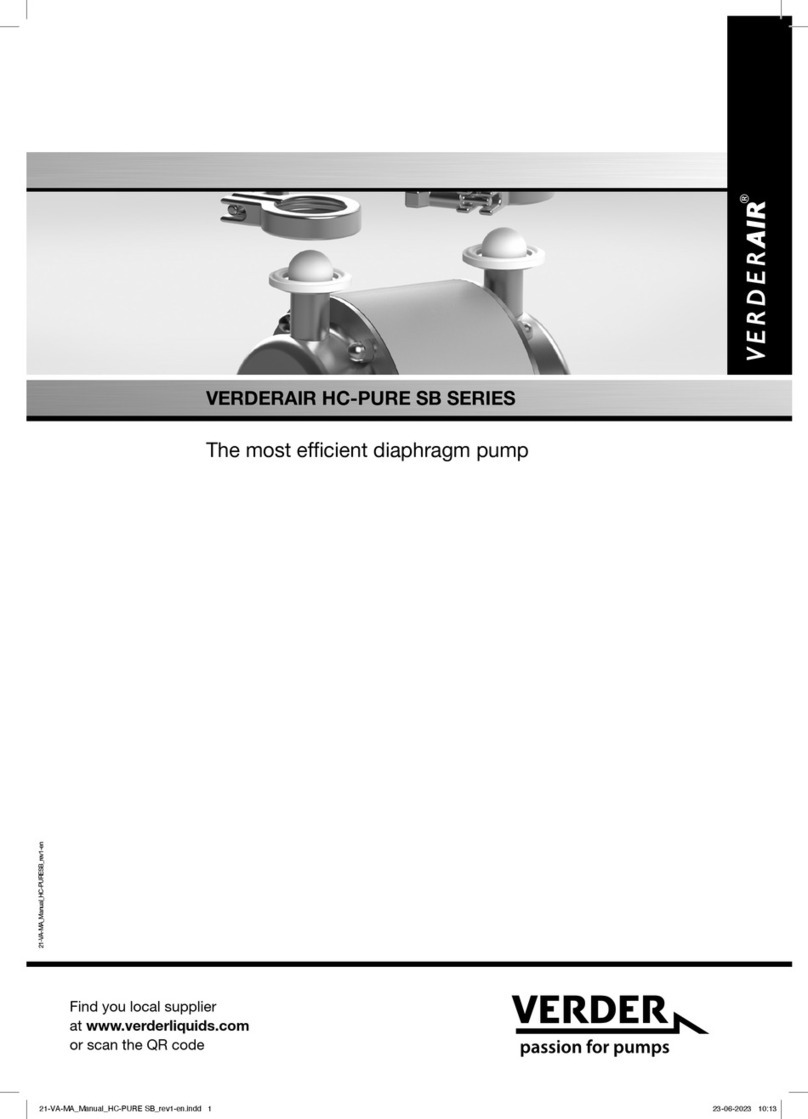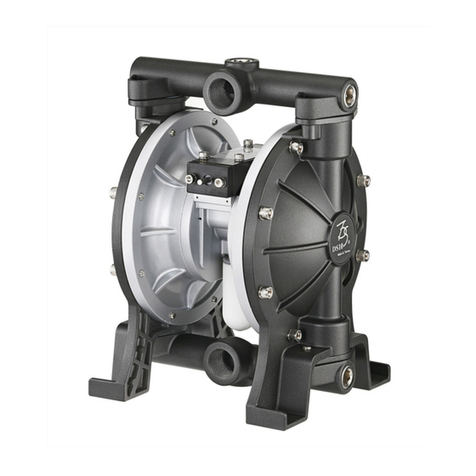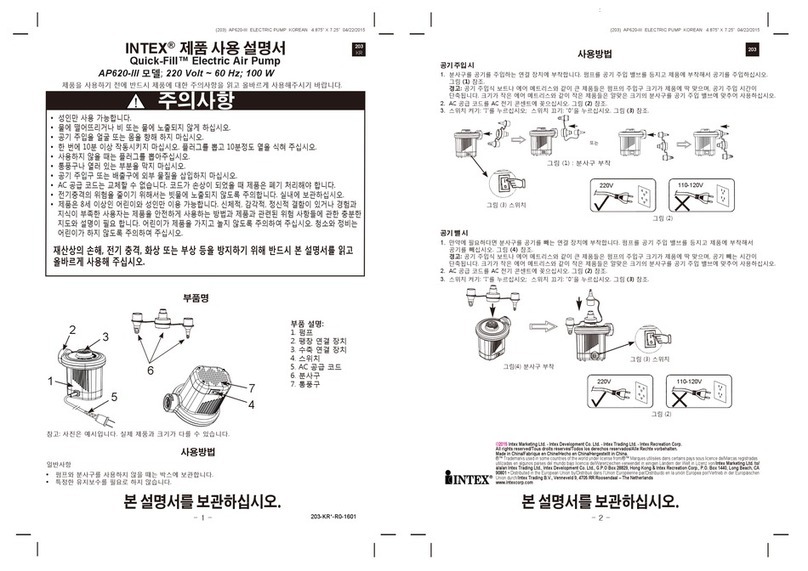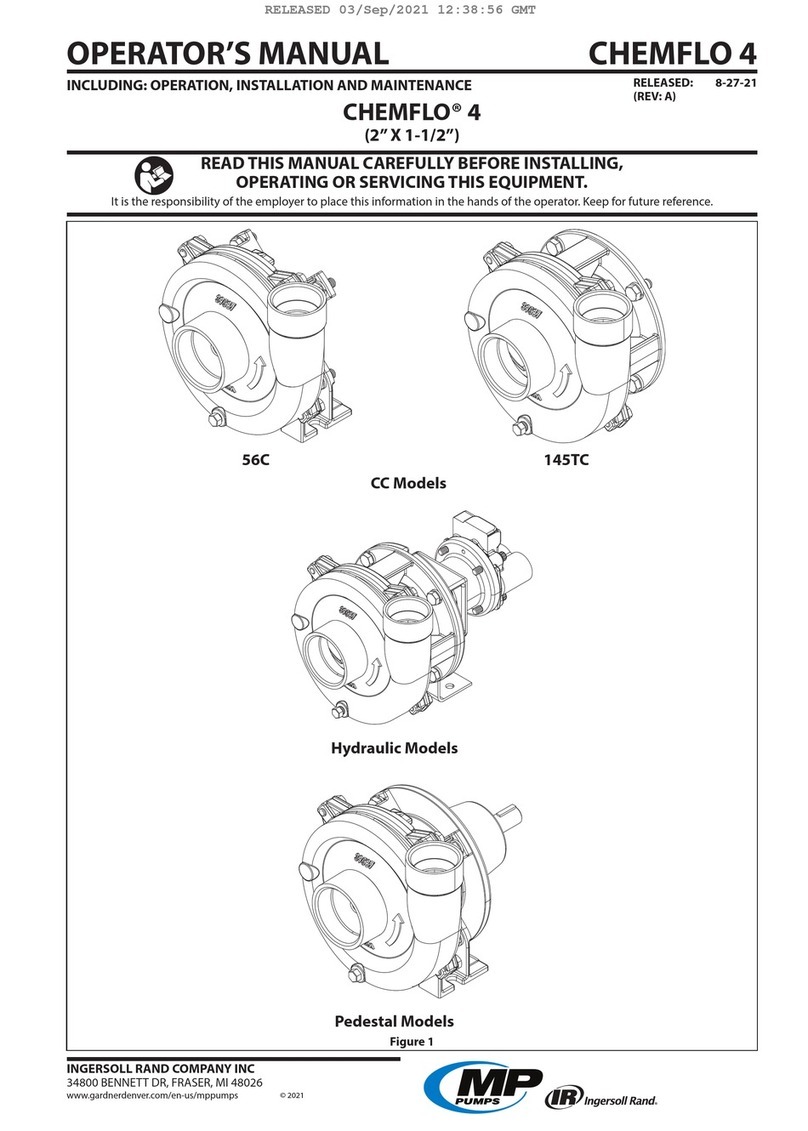Tri-Clover PR Series User manual

PRSM-96
PR Series
Positive Rotary Pumps
Models PR, PRE, and PRED
Service & Installation Manual

- 2 -

- 3 -
CONTENTS
Thank you for purchasing a Tri-Clover Product!
This manual contains disassembly and assembly instructions, maintenance procedures,
troubleshooting, and a complete parts list for all PR Series Pumps designed and manufactured by
Tri-Clover Inc., Kenosha, Wisconsin.
READ THIS MANUAL
carefully to learn how to service these pumps. Failure to do so could result
in personal injury or equipment damage.
SAFETY
IMPORTANT SAFETY INFORMATION .................................................................................................... 4
INTRODUCTION
GENERAL INFORMATION....................................................................................................................... 5
INSTALLATION
UNPACKING AND INSTALLATION ..........................................................................................................6
PIPING HINTS ......................................................................................................................................... 8
MAINTENANCE
MAINTENANCE AND REPAIR ...............................................................................................................12
ROTOR INSTALLATION.........................................................................................................................14
CLEANING AND INSPECTION .............................................................................................................. 15
TROUBLESHOOTING
TROUBLESHOOTING GUIDELINES ..................................................................................................... 17
PARTS LIST
ORDERING INFORMATION .................................................................................................................. 19
PR PUMP............................................................................................................................................... 20
PRE & PRED PUMP ..............................................................................................................................22

- 4 -
SAFETY
DANGER
WARNING
Indicates an imminently hazardous situation which, if not
avoided,
will
result in death or serious injury. The word
Danger is used in the most extreme cases.
Indicates a potentially hazardous situation which, if not
avoided,
may
result in minor or moderate injury. May
also be used to alert against an unsafe operating or
maintenancepractice.
CAUTION
Indicates a potentially hazardous situation which, if not
avoided,
could
result in death or serious injury.
Safety is very important!
DO NOT attempt to modify any Tri-Clover product.
To do so could create unsafe conditions
and void all warranties.
DO NOT place any Tri-Clover product in an application where
general product service ratings are exceeded.
The following DANGER, WARNING, AND CAUTION signs and their meanings are used within
these instructions.
IMPORTANT SAFETY INFORMATION
!

- 5 -
INTRODUCTION
GENERAL
This manual contains installation, operation, cleaning, and repair instructions, with parts list, for
PR, PRE, PRED pumps manufactured by Tri-Clover Inc. of Kenosha, Wisconsin. It also provides
a troubleshooting chart to aid in determining pump malfunctions.
DESCRIPTION
The PR, PRE and PRED Series pump units are generally mounted on base plates which
accommodate the pump units and the drive motors.
The pump units are comprised of two sections, the pump frame section and the fluid head section.
The drive shaft and pump shaft with their respective o-rings, bearings, seal and retaining rings are
located in the inner pump frame section.
The timing gears are keyed to the shafts. Axial movement of the gears is kept to a minimum by
shaft shoulders and retaining rings.
Lip seals on the shafts and o-ring seals on the frame bores, prevent leakage of timing gear
lubricating oil into the pump bearing grease chamber.
Sealing of the fluid head along the shafts is accomplished by rotary seals, consisting of stationary
stainless steel seal rings with carbon inserts, stainless steel wear rings which are broached to fit
the shaft splines, and o-rings which seal off any pumpage.
An optional cover containing a pressure relief valve provides a positive means of protecting the
processing equipment and piping from excessive head pressures.
Rotors are available in two materials - rubber and metal. Rubber and metal rotors are available in
double and four lobe design.
The drive motors, used in conjunction with the PR, PRE and PRED Series Pumps are not covered
in this manual. Refer to the individual motor or drive manufacturer for service data.
WARNING
Before servicing pump, disconnect electrical
power source.
GENERAL INFORMATION

- 6 -
INSTALLATION
UNPACKING AND INSTALLATION
Figure Two
Figure Three
Figure One
Straightedge
Flexible
Coupling
Straightedge
Flexible
Coupling
Taper
Gauge
Straightedge
Flexible
Coupling
CORRECT ALIGNMENT
ANGULAR MISALIGNMENT
PARALLEL MISALIGNMENT
UNPACKING EQUIPMENT
Check the contents and all wrapping when unpacking your equipment. Inspect all parts for
damage that may have occurred during shipping.
Note:
If the plastic pump port covers have been broken or disturbed in shipment,
dismantle fluid head to make sure it is free of all foreign materials before placing
pump in service.
INITIAL LUBRICATION
The pump unit is lubricated at the factory prior to shipping and
will require no additional lubrication until after the pump is put
into service. When you receive the pump:
1. Remove the shipping plug from the top position in the gear
cover and install the vented plug shipped with the pump.
2. Check the oil level in the gear case. Oil should be even
with the plug opening marked with the "oil level" decal. If
oil is required, refer to the
Maintenace and Repair
section
on page 12 of this manual for details.
LOCATION
The pump unit should be located as near as possible to the
liquid source and in a position where the suction piping can be
short and direct with a minimum number of elbows and fittings.
It should also be readily accessible for inspection, cleaning
and lubrication.
FLEXIBLE COUPLINGS
The purpose of a flexible coupling is to compensate for
temperature changes, and allow end movement of the pump
and motor shafts without interference with each other while
transmitting power from the motor to the pump. A flexible
coupling should not be used to compensate for shaft
misalignment.
When properly aligned, the flexible coupling should appear as
shown in the adjoining drawing. See Figure 1.
The faces of the coupling halves should be far enough apart
so that they do not touch each other when the motor shaft is
moved toward the pump.
The tools required for checking flexible coupling alignment are
a straightedge and taper gauge or set of feeler gauges. See Figures 2 and 3.

- 7 -
INSTALLATION
FLEXIBLE COUPLING ALIGNMENT
There are two types of misalignment encountered with flexible couplings, angular misalignment
and parallel misalignment. To check for angular misalignment, insert a taper gauge or feeler
gauge at four places located 90° apart around the coupling as shown. Coupling halves will be
aligned when the measurements are the same at all check points.
To check parallel misalignment, place a straightedge across the coupling half rims at the top,
bottom and both sides, making sure that the straightedge is parallel to the motor and pump shafts.
The coupling will be properly aligned when the straightedge rests evenly on the coupling rims at all
check points.
Correct alignment is obtained by use of shims under the motor mounting feet. Remember that
adjustments made in one direction may affect alignment in another direction. Therefore, several
checks of both angular and parallel alignment should be made.
SEAL FLUSHING - PRED PUMPS
All PRED Series Pumps have double-static o-ring product seals which must have flush liquid
applied to them.
Install seal flush as shown below. Use pressurized flush with products that tend to build up
between seal faces; latex, PVA, etc. Pressure in seal chamber should exceed pump discharge
pressure by at least 10 PSI.
Note:
Your Positive Rotary Pump is designed for either clockwise or counterclockwise rotation.
It should be noted that product flow will be in the same direction as the drive shaft rotation.
Connect the flexible coupling, start the pump and operate it until temperatures are stabilized. The
unit should then be shut down and the alignment immediately rechecked.
Note:
If corrections in alignment are necessary at this time, be sure to check in all directions
after making adjustments.
Figure Four
Seal Flush
Liquid Outlet
to Drain
1/8"- 27 NPT
Seal Flush
Liquid Inlet SEAL FLUSH PIPING
PRED PUMPS WITH
ATMOSPHERIC FLUSH
Adjustable valve
to obtain liquid
flow to both seals
Figure Five
Seal flush liquid outlet to drain
adjust valve to give flow to drain
while maintaining flush pressure
1/4Tubing
SEAL FLUSH PIPING
PRED PUMPS WITH
PRESSURIZED FLUSH
1/8- 27 NPT
Seal flush liquid inlet
adjust pressure to
exceed pump
discharge pressure
Recommended Seal
Flush Flow Rate is
approximately 3 gallons
per hour. For elevated
temperature
applications, flow rate
must be sufficient to
maintain seal
temperature of 175°F or
less.
1/4" Tubing

- 8 -
INSTALLATION
PIPING HINTS
GENERAL
This section provides some do’s and don'ts of piping which will aid in obtaining the maximum
efficiency and service from your pump.
• Piping should be independently supported at both the suction inlet and discharge outlet.
• Care should be taken that piping is properly aligned and does not put any strain on the pump
casing.
• The piping should have as few bends as possible.
SUCTION PIPING
• The suction piping should be short and follow a direct route with a minimum number of elbows
and fittings.
• Elbows should not be used at the suction inlet as friction would be greatly increased, resulting
in head loss.
• Excessive friction losses in the suction line could result in pump cavitation, causing poor
performance, noise, vibration, damage to equipment, and possible damage to product.
• Whenever practical, the diameter of the piping at the suction inlet should be increased in size.
• An eccentric tapered reducer should be used in lieu of a straight concentric tapered reducer to
prevent air pockets from forming and impairing pump efficiency. In turn, the eccentric reducer
may be placed at the inlet of the pump and should be positioned so the straight side is up.
• Although positive displacement pumps are self-priming under moderate suction lift conditions,
a flooded suction is always preferable.
DISCHARGE PIPING
• The discharge piping should be short and direct with a minimum number of elbows and
fittings. It is advisable to increase the pipe diameter at the discharge outlet to minimize head
loss.
PRESSURE RELIEF COVER ADJUSTMENT
Tri-Clover's relief cover is designed for added protection of the pump and other processing
equipment. The product flow will stop or is reduced when the head pressure on the discharge
side of the pump exceeds the pressure rating controlling the piston in the relief cover.
The relief cover is designed for use with either manual or pneumatic controls.
To adjust, install a line pressure gauge in the discharge line of the pump as close as possible to
the discharge port. Determine a maximum line pressure rating that is higher than the operating
pressure and adjust as follows:

- 9 -
INSTALLATION
Manual:
1. Loosen jam nut (09B-6).
2. Turn the adjusting screw (09-5A) (clockwise to increase pressure - counterclockwise to
decrease pressure) until the reading on the pump discharge line pressure gauge is the same
as the predetermined maximum line rating - then retighten jam nut (09B-6).
Pneumatic:*
When back pressure is regulated by pneumatic control, the spring inside the relief cover must be
removed prior to the operation. To remove spring it is necessary to remove relief cover parts in
the following sequence:
1. Jam nut (09B-6).
2. Clamp (13MON-X-S).
3. Cap nut (09B-3A).
4. Retaining ring (09B-13).
* For PR300 replace cap nut (09B-3A), adjusting screw (09B-13) and jam nut (09B-6) with
R3-1-09D-3 cap.
Reassemble relief cover omitting retaining ring (09B-13) and spring (09B-4) and follow instructions
below for pneumatic operation:
1. Loosen jam nut (09B-6).
2. Turn the adjusting screw (09B-5A) counterclockwise until o-ring (09B-14) is slightly
compressed, then retighten jam nut (09B-6).
3. Adjust pressure control valve at the source of supply (air or CO2) until the reading of the
discharge line pressure gauge is the same as the predetermined maximum line pressure
rating.

- 10 -
MAINTENANCE
WARNING
Before servicing the pump, disconnect the electrical
power source, carefully relieve all pressure, and drain all
fluids from the pump and connected piping.
CLEANING
DISASSEMBLY OF PUMP FLUID HEAD
It is necessary to disassemble parts of your pump for cleaning and sanitizing. Disassemble as
described below after disconnecting the suction and discharge piping. If so equipped, also
disconnect the relief cover air line.
Note:
For added protection when disassembling pump fluid head, place all parts on rubber mat
or wooden platform. Extreme care must be exercised during assembly and disassembly
of the fluid head - especially in handling of the rotary seal parts and rotors.
1. Remove casing nuts and slide the casing cover off the casing studs. Carefully remove the o-
ring from the inside of the cover.
2. Remove the rotors from the drive and pump shafts.
3. Slide the casing off the studs.
4. Carefully remove the casing o-rings from the rear of the casing.
5. Slide the seal rings off the shaft.
6. Remove the wear rings. If necessary use Puller No. R80-200 supplied with your pump. Do
not pry wear rings off with a screwdriver or similar tool as the flanges may be damaged.
Carefully remove shaft o-rings. On PRED models, with double seal assemblies, remove rear
seal rings and o-rings.
Seals: Inspect the carbon face of the seal ring and the wear ring seal surface for nicks, scratches
or excessive wear. Inspect all o-rings for cuts, abrasions or wear. Replace any damaged or worn
parts.
Rotors: Inspect rubber rotor for cuts, cracks or other damage to the rubber composition. Inspect
metal rotor carbons for cracks or wear and replace if damaged. Check fit of metal or rubber rotors
on shafts and replace if excessively loose.

- 11 -
MAINTENANCE
REASSEMBLY OF FLUID HEAD
Note:
Sequence of disassembly and assembly is the same for models PR, PRE and PRED
except where noted.
To reassemble the fluid head:
1. Lubricate shaft o-rings with silicone grease (Tri-Clover L1011B) and insert o-rings into grooves
on shafts.
2. On PRED models, insert rear seal o-rings into alignment locating ring.
3. Slide rear seal rings into place in alignment locating ring.
4. For all models slide wear rings into place onto the shafts.
5. Slide seal rings into place. DO NOT LUBRICATE SEAL FACES EXCEPT WITH CLEAR
WATER. USE OF SANITARY LUBRICANTS MAY DAMAGE CARBON. TANGS ON THE
SEAL RINGS MUST BE ALIGNED WITH SLOTS IN CASING. SEAL AND PUMP CASING
CAN BECOME PERMANENTLY DAMAGED IF TANGS ARE NOT PROPERLY ALIGNED.
6. Insert casing o-rings into place on back of casing.
7. Slide casing securely into place.
8. Slide rotors in place over splined shafts.
9. Insert cover o-ring.
10. Place front cover in position on studs.
11. Replace and tighten the casing nuts.
12. Reconnect the suction and discharge piping.

- 12 -
MAINTENANCE
MAINTENANCE AND REPAIR
Maintenance of the PR, PRE and PRED pumps includes frequent lubrication of the shaft bearings,
checking the oil level in the timing gear compartment, changing of oil at regular intervals, and
inspection of pump components.
LUBRICATION OF OUTBOARD AND INBOARD BALL BEARINGS
The bearings should be greased after every 100 operating hours, using ahigh quality grease such
as Mobile Temp #1. Old grease in the grease chamber should be periodically removed by
removing the cleanout hole cover and scraping out excess grease. Mixing of different brands of
grease should be avoided, to prevent possible chemical reactions between the brands, which
could damage the bearings. Greases containing vegetable or animal bases should not be used
because they can develop harmful acids. Also avoid using greases containing graphite, rosin, talc
and other impurities.
Note:
Be sure the lubrication fittings are wiped clean before greasing, to prevent dirt from being
forced into the bearings during greasing.
If your pump has been operated under extremely dusty or wet conditions for several months, or
has been idle for a long period of time, the bearings should be cleaned thoroughly with white
gasoline or kerosene and new grease applied. Refer to the applicable paragraph for disassembly,
cleaning and inspection procedures.
LUBRICATION OF TIMING GEARS
The timing gears are lubricated with SAE 20 oil. At regular intervals check the oil level by
removing the oil level plug. Oil should be even with the bottom of the plug opening.
Every 200 operating hours, remove drain plug and drain the timing gear chamber. Add new oil
until proper level is reached.
DISASSEMBLY
It is recommended that periodic inspection of all parts be made to prevent malfunction caused by
worn or broken parts. To accomplish this inspection, it is necessary to completely disassemble
the pump. Sequence of disassembly is the same for models PR, PRE and PRED.
Disassembly of the Casing and Rotor
1. Disconnect the suction and discharge piping. Also disconnect the water line to the shaft seal
flush assembly, if pump is so equipped.
2. Remove the four bolts securing the pump to the base plate.
Note:
If the pump is removed from the base plate, be sure that any shims used to level the
pump are fastened together by some suitable means, tagged and reinstalled at their
original location at time of reassembly.
Disconnect the flexible coupling half from the pump shaft.
3. Remove the coupling key from the shaft. Remove casing nuts and slide casing cover from
studs. Carefully remove casing cover o-ring.
4. Disassemble the relief cover, if used, by removing the jam nut, clamp, cap nut and gasket.
Remove the retaining ring and slide the adjusting screw spring and thrust washer from the
piston. Carefully remove the o-ring from the adjusting screw.

- 13 -
MAINTENANCE
5. Remove the piston from the relief cover and carefully remove the o-rings and PTFE sleeves
from the piston.
6. Slide off the drive shaft and pump shaft rotors.
7. Remove the casing and carefully remove the casing o-rings.
8. Slide the seal rings of the shafts and carefully remove wear rings. If necessary use Puller No.
R80-200. Do not pry off with a screwdriver or similar tool which may bend flange area of wear
ring.
Note:
Do not use a screwdriver or a pointed tool to remove seals and o-rings. The seals and
o-rings are precision parts and are easily damaged.
9. Remove the shaft o-ring by placing the thumb of one hand and forefinger across the diameter
of the o-ring and pressing it with a circular motion so that the o-ring projects from the groove.
With the forefinger of the other hand work the o-ring from the shaft groove.
10. Remove the vented plug and the oil level plug. Drain the oil from the timing gear case by
removing the drain plug. Remove the gear cover cap screws and the gear cover.
11. Carefully remove the gear cover gasket.
12. Press out the gear cover seal if replacement is necessary.
13. Remove the timing gear retaining ring (Part No. 98) from each shaft. On models PR300,
PRE300 and PRED300, bend back the tab on lockwasher (Part No. 69), and remove locknut
(Part No. 22) and lockwasher.
14. Use suitable pullers and remove the timing gears.
15. Remove the woodruff keys from shafts.
16. Remove the outboard bearing cover retaining rings.
17. Press each shaft and bearing assembly through the housing from the rotor end. If a press is
not available, a soft hammer or a block of wood can be used to drive the shaft from the
housing.
18. Remove the outboard bearing cover and o-ring. Push out the bearing cover seal if
replacement is required.
19. If it is necessary to remove the alignment locating rings, use a long punch to tap them from
the inside of the frame. Note the original positions of these rings. The grooves in the rings
must be carefully aligned with grease fittings at reassembly. Press the seal from the
alignment locating ring if replacement is necessary.
No further disassembly is recommended unless inspection shows that replacement of bearings or
shafts is required. If bearings are to be replaced, remove the bearing retaining ring. Using a
bearing puller or an arbor press, remove the damaged bearing from the shaft.

- 14 -
MAINTENANCE
Your Tri-Clover pump will operate only if the rotors are
correctly installed. Therefore carefully follow the
installation procedure listed below.
TWO LOBE ROTORS
1. Install 2D rotor onto top shaft.
Note:
It doesn't matter whether top shaft is pump
shaft or drive shaft.
2. After installing 2D rotor, rotate shaft if necessary to
obtain spline relationship as shown in Figure 6.
3. Install 2P rotor on lower shaft. 2P rotor must be
installed as shown in Figure 6. Rotors must form a
"T" shape when properly installed with the tip of
one rotor opposite the concave hub areas of the
mating rotor.
Note:
Pump cannot be operated unless the
above procedure is followed. If rotors are
not installed as shown, the pump will jam
when started resulting in damage to the
rotor or shaft.
SINGLE LOBE ROTORS
1. Install 1D rotor onto top shaft.
Note:
It doesn't matter whether top shaft is pump
shaft or drive shaft.
2. After installing 1D rotor, rotate shaft if necessary to
obtain spline relationship as shown in Figure 7.
3. Install 1P rotor on lower shaft. 1P rotor must be
installed as shown in Figure 7. Large lobe of one
rotor must be next to small diameter or hub of
mating rotor.
Note:
Pump cannot be operated unless the
above procedure is followed. If rotors are
not installed as shown, the pump will jam
when started resulting in damage to the
rotor or shaft.
ROTOR INSTALLATION
Figure Six
Part 2D - Center line of wide spline
teeth is on center line of rotor
lobes.
Part 2P - Center line of wide spline
teeth is at a 45° angle with
center line of rotor lobes.
2D
2D2P
2P
Figure Six
Part 1D -Center line of wide spline teeth
is on center line of rotor lobes.
Part 1P -Center line of wide spline teeth
is at a 45° angle with center
line of rotor lobes.
1D 1P
1P 1D

- 15 -
CLEANING AND INSPECTION
1. Remove cleanout hole cover, and remove any accumulation of grease from inside of the
grease chamber.
2. Inspect the pump frame, gear cover and casing for cracks or other damage that could impair
function of the pump.
3. Clean the outside of the frame, shaft, timing gears and bearing covers with a clean rag soaked
in white gasoline or kerosene, and flush all surfaces.
4. Flush the inside of the pump frame with white gasoline or kerosene to remove any harmful
material. Dry with compressed air or allow solvent to evaporate.
Note:
Clean rotor end of the shaft thoroughly after reassembly to remove any solvent that
could contaminate the process fluid.
5. Inspect the shafts carefully for nicks or scratches. Remove small nicks or scratches with a
fine file or emery cloth.
6. Examine the bearing covers and rotors for cracks or other signs of excessive wear.
7. Examine the keyslots in shafts and gears and woodruff keys for signs of wear. Keys must fit
tightly in key slots.
SEAL INSPECTION - SEAL RING
1. Inspect the carbon face of the seal ring and seal ring chamber for nicks and scratches on the
sealing surfaces.
2. Carefully inspect the wear ring for excessive wear.
3. Examine the bearing cover seal, alignment ring seals, and the gear cover seal for cracks,
nicks and excessive wear.
4. Inspect all o-rings for cuts, abrasions or other wear that can cause leakage.
5. Carefully examine the gear cover gasket and cleanout cover gasket for nicks, cuts, scratches
or excessive wear.
Parts showing excessive wear should be replaced.
REASSEMBLY
If it is necessary to replace the bearing cover seals or alignment ring seals, the new seal must be
installed with the spring loaded seal lip facing away from the bearings. The spring loaded seal lip
on the gear cover seal must face the gears.
If it is necessary to replace the bearings:
1. Press the bearings onto the shaft and install the bearing retainer ring (Part No. 102).
2. Install the inboard shaft retainer ring (Part No. 177) in the pump frame.
3. Place the outboard bearing cover seal, outboard bearing cover and outboard bearing cover o-
ring on the shaft.
4. Stand the pump on the eight studs and start the shaft through the pump frame.
5. Press the shaft until the bearings are firmly seated*. Install the outboard bearing cover
retainer rings (Part No. 177). Lubricate the bearings.
* These bearings are an easy fit, and will not require much force.
MAINTENANCE

- 16 -
6. Install the woodruff keys in the shaft keyslots and press the
timing gears onto the shafts.
7. Carefully align the timing marks on the gears as shown in Figure
Eight.
8. Install the timing gear retaining rings (Part No. 98).
9. On Model PR300, PRE300 and PRED300 pumps, assemble
lockwasher (Part No. 69) and locknut (Part No. 22) on the shafts.
10. Tighten locknut firmly and lock in place by bending a tab into a
slot on the locknut.
11. Insert seal in gear cover, carefully fit the cover gasket to the
cover and secure the gear cover to the pump frame with the cap
screws.
12. Install the drain plug, fill the oil reservoir to the proper oil level
and install the vent plug and the oil level plug.
13. Assemble the cleanout cover to the pump frame.
14. Install the alignment locating rings. Be sure to align the slots in these rings with the grease
fittings.
15. Install the shaft o-rings and the wear rings.
16. Slide the seal rings onto the shafts and carefully align the tangs of the seal rings with the slots
in the casing.
17. Assemble the casing o-rings and casing and slide into place.
Note:
The seal rings and pump casing can become permanently damaged if tangs are not
properly aligned. Do not lubricate seal faces. Carbon will be damaged if lubricated.
18. Install the rotors and place casing cover o-ring in casing cover groove. Secure the cover to
the casing with the casing nuts.
19. Assemble relief cover in the reverse order of disassembly.
20. Rotate the drive shaft. If the pump rotates smoothly and is not leaking oil, mount it on the
base, and connect the flexible coupling to the pump shaft.
21. Align the coupling according to instructions given under the
Installation
section of this manual.
IMPORTANT:
Be sure the bearings have been lubricated and gear oil added before placing
the pump back in service.
22. Connect the suction and discharge piping, and the water line to the seal flush assembly.
23. Reset pressure relief valve as described in relief cover adjustment.
MAINTENANCE
Figure Eight
Timing Gears and Marks
Timing
Marks

- 17 -
TROUBLESHOOTING
PROBLEM PROBABLE CAUSE REMEDY
1. No discharge a. Pump speed too slow. a. Correct wrong or poor electrical
connections.
b. Wrong direction or rotation. b. Reverse a three-phase motor by switching
anytwo of three power leads at the motor
or controller. Reverse a single phase motor
according to motor nameplate insturctions.
c. Closed valve. c. Open valve.
d. Obstruction in discharge d. Clear obstruction.
piping.
2. Insufficient a. Pump speed too slow. a. See 1.a. above.
discharge b. Valve partially closed. b. See 1.c. above.
c. Obstruction in discharge c. See 1.d. above.
piping.
d. Rotor damaged. d. Replace rotors.
e. Air leak in suction line. e. Check suction line joints.
f. Cavitation f. See note at beginning of
Troubleshooting
section.
3. Excessive a. Motor speed too high. a. Internal motor wiring is incorrect
power replace motor; check line voltage.
consumption b. Rotors are binding. b. Relieve strain on casing; replace
defective rotors.
c. Motor shaft is bent or worn. c. Replace shaft.
d. Power frame shaft is bent d. Replace shaft.
or worn.
e. Power frame bearings are e. Replace bearings.
worn.
f. Excessive misalignment f. Align pump and driver.
between pump and driver.
Tri-Clover pumps are relatively maintenance free with the exception of sanitizing and lubrication.
Like any piece of machinery, however, occasional problems can arise. The troubleshooting chart
provides a means of determining and correcting most of your pump problems. The motor
manufacturer should be contacted for specific repair instructions on the motor.
Note:
The troubleshooting chart has been prepared on the basis that the pump as installed has
been properly suited to its application. Should problems arise where the remedies listed
in the troubleshooting chart do not cure the situation, pump cavitation may be the
problem. Symptoms of pump cavitation, such as noisy operation, insufficient discharge
and vibration, can result when a pump is not properly applied. If these conditions are
present, check the system and reevaluate the application. If assistance is required,
contact Tri-Clover.
TROUBLESHOOTING GUIDELINES

- 18 -
PROBLEM PROBABLE CAUSE REMEDY
4. Pump is noisy a. Magnetic hum. a. Consult motor manufacturer.
b. Motor bearings are worn. b. Replace bearings.
c. Foreign matter is rotating c. Remove casing and remove
with impeller. foreign matter.
d. Rotors are binding. d. See 3.b. on the previous page.
e. Motor shaft is bent or worn. e. See 3.c. on the previous page.
f. Power frame shaft is bent f. See 3.d. on the previous page.
or worn.
g. Power frame bearings are g. See 3.e. on the previous page.
worn.
h. Excessive misalignment h. See 3.f. on the previous page.
between pump and driver.
i. Cavitation. i. See note at beginning of
Troubleshooting
section.
5. Excessive a. Pump is not leveled properly. a. Level pump.
vibraton b. Excessive misalignment b. See 3.f. on the previous page.
between pump and driver.
c. Rotors are damaged. c. Replace rotors.
d. Piping is not supported. d. Support discharge and suction piping.
e. Power frame shaft is bent e. See 3.d. on the previous page.
or worn.
f. Cavitation. f. See note at beginning of
Troubleshooting
section.
6. Pump leaks a. Casing cover loose. a. Tighten casing nuts.
b. Damaged inlet or outlet b. Replace casing.
fittings.
c. Casing cover o-ring c. Replace o-ring.
defective.
d. Casing o-rings defective. d. Replace o-rings.
e. Mechanical seal worn or e. Replace seal.
defective.
TROUBLESHOOTING

- 19 -
PARTS LIST
ORDERING INFORMATION
ORDERING REPAIR PARTS
All orders for repair parts must contain the following data.
1. Complete model number (located on nameplate).
2. Pump serial number (located on nameplate).
3. Description and part number from parts list.
The exploded views and accompanying parts lists in this section facilitate ordering repair parts
from the factory. All parts of the pumps are exploded and keyed to the parts list.
ORDERING IMPELLERS
When ordering impellers, the base number designates the impeller size. To order a pump
impeller, specify the following:
0000 00 00 0000
MODEL
SIZE
R3
R10
R25
R60
R125
R300
IMPELLER
KEY NUMBER
This number will
always be 02
1
3
2
BASELINE
PORT
smallest
available
port size
DRIVE OR PUMP
SHAFT IMPELLER
(BILOBE ONLY)
D - Drive Shaft
P - Pump Shaft
5
CLEARANCE
Rubber
Impellers
Only
C - Cold
H - Hot
6
4
NUMBER
OF LOBES
2
4
6
ELASTOMER
U - Buna N
Y - Fluoroelastomer/
SFY
E - EPDM
7
MODEL NUMBER EXAMPLE
R10 - 1½ - 02 - 2PH - U
1 2 3 4 5 6 7
Click here to Order Parts

86B
09
90A
02
01
19
93
133
59A
59
59B
73
58
58A
175
175A
179
128
80-4B
80-2A
80-1
80-3A
35
35A
47
102
177
16
12
96
46
18
37
37A
49
177
94A
98
02 80-2A
80-1
80-3A
35
35A
47
102
177
16
96
06
37
37A
49
177
94A
98
86
18 130
80-4B
Drive Shaft And Components
for the PR300 Pump
12
96
46
18
49
37
37A
177
94A
69
22
PR PUMP
177
102
16
PARTS LIST
06
Pump Shaft for
PR300 Pump
- 20 -
Click here to Order Parts
This manual suits for next models
20
Table of contents
Other Tri-Clover Water Pump manuals
Popular Water Pump manuals by other brands

Xylem
Xylem FLOJET 4105 Series instruction manual
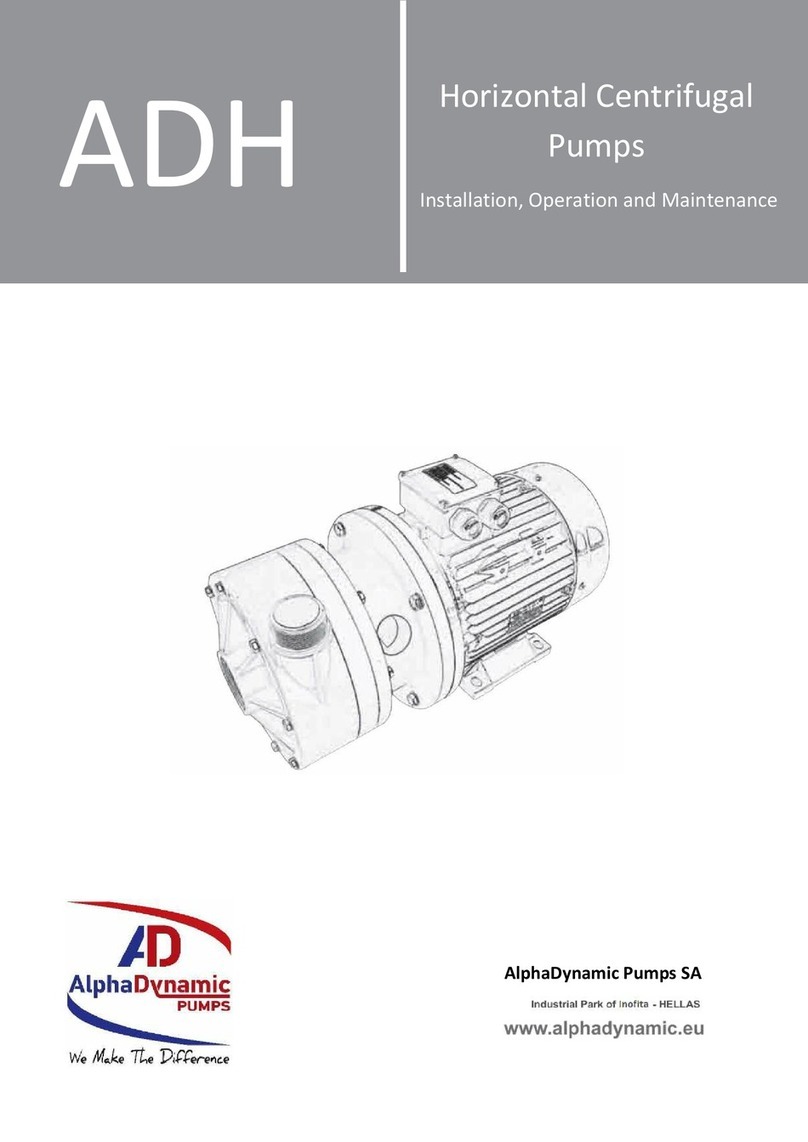
ALPHA DYNAMIC PUMPS
ALPHA DYNAMIC PUMPS ADH Series Installation, operation and maintenance instructions
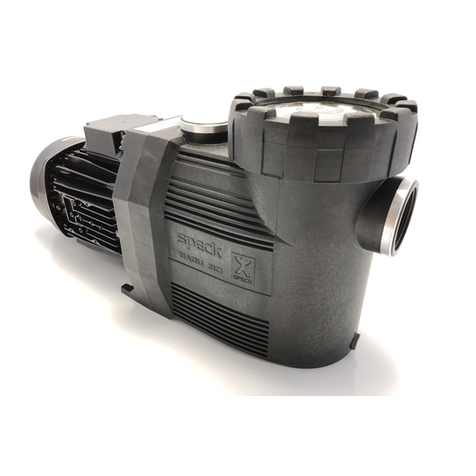
Speck pumpen
Speck pumpen B9 Series Installation and operation instructions
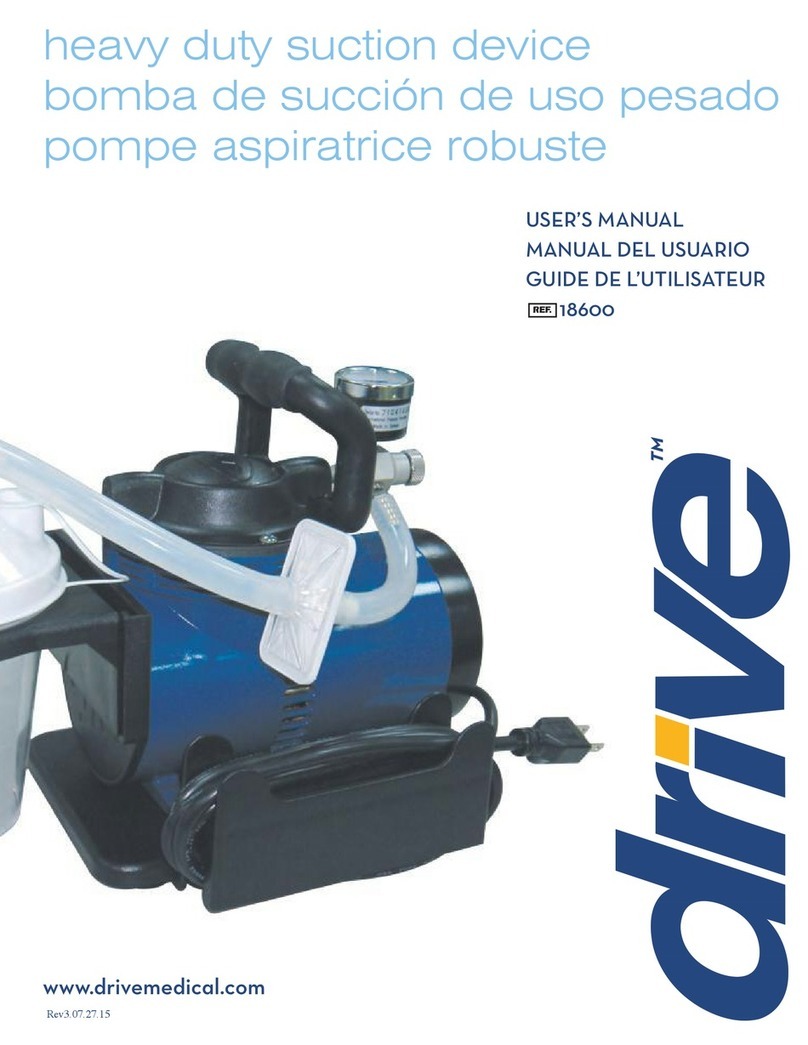
Drive
Drive Heavy Duty Suction Device user manual

Pfeiffer Vacuum
Pfeiffer Vacuum HEPTA DRY 100 operating instructions
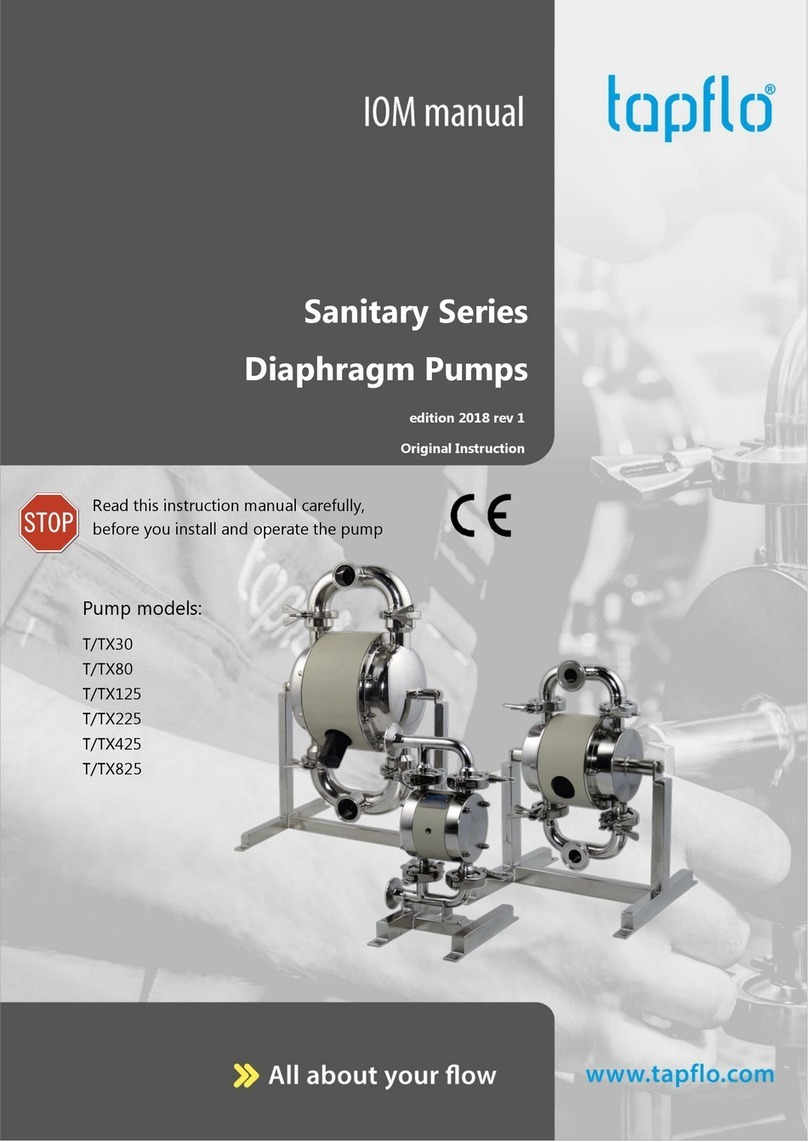
TapFlo
TapFlo Sanitary Series IOM manual
